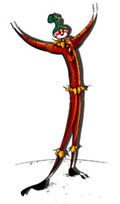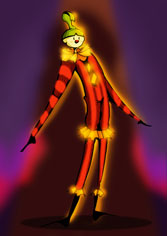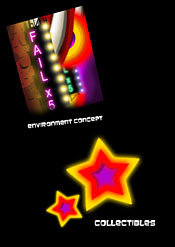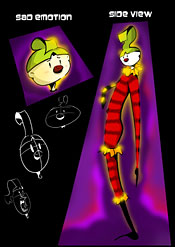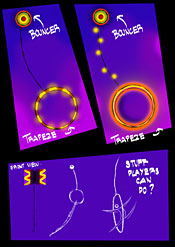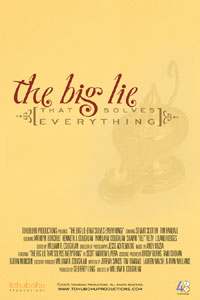|
|
 Early in January I announced that I’d been invited to blog occasionally for the Interstitial Arts Foundation. Here’s what I hadn’t told you yet: I’ve also accepted the invitation to join the IAF’s Executive Board.
I’m both honored and excited to be working with the IAF. The group counts among its members a number of true luminaries currently working in the creative arts, and its mission of promoting works that fall outside of traditional genre boundaries is very near and dear to my heart. Keep an eye on this space, as well as over at www.interstitialarts.org, for more information – and if your interests also lie along interstitial lines (as many fans of such creators as Neil Gaiman, Jonathan Carroll, Holly Black, Ellen Kushner, Gabriel Garcia Marquez, Umberto Eco, Henry Jenkins, JJ Abrams, Joss Whedon, Warren Ellis, Gregory Frost, Delia Sherman, Weird Tales magazine, Comparative Media Studies, and a billion other interesting things are likely to be), please consider joining me as a friend of the IAF. It’s a brilliant group of people and an incredibly exciting place to be right now – consider yourself invited along for the ride!

February 3, 2009
12:10 pm
One of the awesome things about GAMBIT is the never-ending stream of fascinating folks that stop by our lab for a visit. Such previous guest-stars have included Mia Consalvo, Denis Dyack, Jason Rohrer, Warren Spector and Chris Swain, and this week our lab is pleased to welcome the brilliant and inestimable Dr. Celia Pearce.
Readers of this blog may know Dr. Pearce from her work as the director of the Experimental Game Lab at Georgia Tech; from her work as the Festival Chair for the independent games festival IndieCade; from her 1997 book The Interactive Book: A Guide to the Interactive Revolution; or from her many other projects as outlined on her website Celia Pearce and Friends.
GAMBIT is pleased to invite anyone within traveling distance to a public talk by Dr. Pearce this Thursday evening here on the MIT campus. The talk, part of the MIT Comparative Media Studies Spring 2009 Colloquium Lecture Series, will be held on Feb. 5, 2009 from 5-7PM in Room 2-105. Here’s the description:
Identity-as-Place: Fictive Ethnicities in Online Games & Virtual Worlds
This talk explores the connection of identity to virtual place, referencing in particular anthropology, humanist and socio-geography and Internet studies to look at the construction and performance of “fictive ethnicity” tied to a specific, though virtual and fictional, locality. To illustrate, Pearce will use the example of the “Uru Diaspora,” a game community from the defunct massively multiplayer game Uru: Ages Beyond Myst (based on the Myst series), which immigrated into other games and virtual worlds, adopting the collective fictive ethnicity of “Uru Refugees,” and referring to Uru as their “homeland.” The study referenced concerns the largest group of Uru refugees, who immigrated into the virtual world There.com. These players developed unique hybrid cultures other games, including the creation of Uru-inspired digital artifacts, and through an eventual process of “transculturation” (Ortiz 1947) eventually transformed from “Uruvians” into “Uru-Thereians,” integrating both virtual places into their collective identity. Through this example, Pearce will argue that in the current historical moment, in which connections between identity, community and place are being supplanted by the generic placenessness and identilessness of “global markets,” the tendency of players in the Uru Diaspora to construct a shared, place-based identity may reflect a larger need by individuals to associate themselves with affinity groups and reclaim a sense of connection between a specific locality (place), community and identity.
Celia Pearce is a game designer, author, researcher, teacher, curator and artist, specializing in multiplayer gaming and virtual worlds, independent, art, and alternative game genres, as well as games and gender. She began designing interactive attractions and exhibitions in 1983, and has held academic appointments since 1998. Her game designs include the award-winning virtual reality attraction Virtual Adventures (for Iwerks and Evans & Sutherland) and the Purple Moon Friendship Adventure Cards for Girls. She received her Ph.D. in 2006 from SMARTLab Centre, then at Central Saint Martins College of Art and Design, University of the Arts London. She currently is Assistant Professor of Digital Media in the School of Literature, Communication and Culture at Georgia Tech, where she also directs the Experimental Game Lab and the Emergent Game Group. She is the author or co-author of numerous papers and book chapters, as well as The Interactive Book (Macmillan 1997) and the forthcoming Communities of Play: Emergent Cultures in Multiplayer Games and Virtual Worlds (MIT 2009). She has also curated new media, virtual reality, and game exhibitions and is currently Festival Chair for IndieCade, an international independent games festival and showcase series. She is a co-founder of the Ludica women’s game collective.
We would like to extend the warmest of welcomes to Dr. Pearce, and we hope to see you all on Thursday evening!

GAMBIT would like to extend its heartiest congratulations to Steven Bartel (Muzaic, Ochos Locos, NeuroTrance, TenXion) and Mark Sullivan III (Moki Combat, NeuroTrance, gunPLAY, AudiOdyssey) who won two of MIT’s biggest competitions this past week.
Bartel and three of his friends spent the past several weeks writing code for MIT’s 6.370 BattleCode competition, an annual event that pits teams of MIT students against each other in a harrowing match of artificial intelligence programming skills. Here’s an excerpt from fellow GAMBIT alumni Eitan Glinert‘s detailed summary of the event:
Each round of the compeition was a best of three match up in which teams who were eliminated early on move down to a loser’s bracket, with the winner of the loser’s bracket having a chance for redemption if they can beat the winner twice in a row.
Each match up was fought one of a set of several simple 2D maps which featured variable terrain and obstacles. Within each map were a few randomly placed “flux” (i.e. points) mines, and a team could win by gaining much more flux than their opponent. Flux mines needed to be controlled by a team in order to collect flux, and therefore these points were often the focus points of skirmishes due to their high value.
Each team started with a set of 6 flying, non-replaceable, self repairing archons which were the most valuable units in the game. Archons couldn’t attack directly, but could spawn other disposable attack units like soilders and cannons. These attack units were useful as they could be used to attack (and potentially destroy) archons, tipping the tide of the game.
Several strategies were employed in the game, including having archons mass together and attack as a unit while ignoring flux in an effort to destroy the opposing team early. Another strategy was to split up and mine flux like crazy, hoping to survive enemy onslaughts. One of the more creative stratgies (employed by Greg from Rob Miller’s HCI group at CSAIL) involved sending gigantic messages to enemies which would actually overload their message handlers, causing their scripts to fail in a sort of information warfare. The most successful teams would adapt to their enemies between match ups within rounds to exploit what they learned in the previous match up.
Check out Eitan’s complete report for the nail-biting details!
Meanwhile, Mark Sullivan and his team won another of MIT’s annual events, the 6.270 Autonomous LEGO Robot Design competition. Pictures are available of Mark and his robot in the Tech and a whole mess of other images at the event website. Added coolness points? Sullivan’s team, Team 3, named their bot GLaDOS. Now where have we heard that name before…?
Congratulations, guys! We’re proud of ya!

The Independent Games Festival recently announced the finalists for this year’s Seamus McNally Grand Prize, and all of us here at GAMBIT were thrilled to find our game CarneyVale: Showtime included on the list. Showtime, which was developed by the GAMBIT Singapore Lab using XNA and is available for download now on Microsoft’s Xbox LIVE community service, is the spiritual sequel to our summer 2007 prototype game Wiip. We sat down Desmond Wong, a recent graduate of Nanyang Polytechnic who was the lead artist for both Showtime and Wiip, to discuss how art was used to link the growing CarneyVale franchise together.
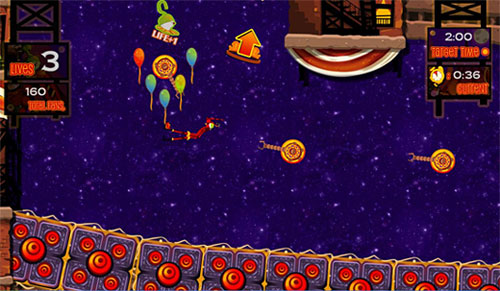 CarneyVale: Showtime CarneyVale: ShowtimeHow was the art style chosen for Wiip?
During the concept stages of Wiip, the team was trying to settle on a suitable theme for a whipping game. We tried all sorts of ideas and eras ranging from cowboy western to jungle tribal. However, none of the themes had that special factor to them, they felt too overused and unoriginal. Eventually, the idea of being a ringmaster settled in. We knew it would be cool to be a raging ringmaster with a ferocious whip, and the idea of a mysterious circus quickly came into play.
My initial concepts for Wiip were very dark and creepy, with outlandish animals and clowns. Although interesting, we knew that we needed something cuter and more approachable. Fortunately, the team had another artist who drew really cute and wonderful things. We had her take a stab at the early concepts, and she came up with her own cuter renditions. Eventually, the final product ended up as something both cute and creepy at the same time, a perfect balance between the two.
How did the art style change between Wiip and Showtime?
If Wiip was the growing child, then Showtime is the maturing teenager. For Showtime, the art style took a more circus city feel to it. It was literally a city with circus performances on its streets. With that, we could have all assortments of neon signs, glowing lights and bustling color. The genral rendering of the characters also took a more mature turn. instead of kiddy characters, the characters in Showtime are more proportionate and grown. The style of shading also changed, employing more tones of shade and detail.
Despite all the changes, the art style was generally kept to roughly the same feel. The bright and colorful characters and scenery were still present, and the quirky designs never disappeared. It was just an art style evolving as time went on.
Who or what would you cite as the inspirations behind CarneyVale’s art style?
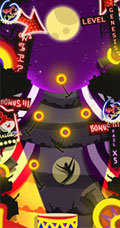 The biggest inspirations for the art style for Showtime were definitely Cirque du Soleil and Las Vegas. I remember the team watching video performances by the Cirque du Soleil troupe, and the costume designs just blew my mind away. Las Vegas was also a huge inspiration to the art style. Being a city circus, I looked to Las Vegas for its neon lights and signboards to give life to CarneyVale. I also used Las Vegas a lot when trying to merge a circus and city together. I would look at photos of that city, and imagine it with circus elements on it, and it would always work.
Artists such as Yoji Shinkawa also give me tons of inspiration. Famous for his work in the Metal Gear series, what I really like about his works is his ability to generate such a distinct style of his own. The way he paints and conceptualises his ideas are what I respect most about this particular artist.
<a href="http://video.msn.com/video.aspx?vid=9c5941d9-8996-41e6-aaa1-e2c127bf19b2" target="_new" title="CarneyVale: Showtime trailer ">Video: CarneyVale: Showtime trailer </a>
The trailer for Showtime
How did you consciously use the art style to tie Wiip and Showtime together?
The colors were the main things. When I was working on Showtime, I made sure that my color palette contained all the colors I used with Wiip. This was mainly the reds and yellows, however, I made sure to inject new tones and colors to keep things fresh. I also made sure to include the familiar red and white curtains from Wiip in Showtime as well. This served as a link between the two games, and added a distinct circus vibe to the game as well.
The general details for the items in the world were also kept consistent to tie the two games together. For example, I employed a certain motif in Wiip that I reused on some of the props in Showtime to keep the world whole and seamless. Most importantly, the narrator for Showtime is the main character from Wiip. No better way to tie two games together than that.
What’s your usual workflow like? How do you go about creating a piece of art for the game?
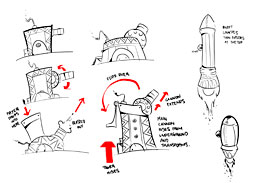 Usually I start with an idea. Ideas can come from anywhere. I got the idea for the Grabber prop by walking past those toy machines where you had to direct a hand to grab the toy you wanted. When I have a general idea down, I take it to the paper and pen. I sketch my ideas out and make sure to do as many variations of it as I can. I also find it very useful to get input from the people around me at this stage when the idea is still fresh and at its infant stage.
Around this point, I start choosing the best few concepts and proceed to creating art for the game. I use Photoshop to draw out and color the art, and once that is done, I export it out and get it ready to be put into the game. From here on, it’s mostly seeing what works and what does not. For example, the launcher for the missile looked good on paper, but when it was put into the game, it was a little too big and bright. The good thing is that once the art is there, it’s mostly just tweaking to strike the perfect balance between making it look good and work well too.
If you were to do a third game in the series, what new types of imagery would you like to explore?
Wiip took place inside a busy circus tent, and Showtime took place in a bustling city at night. For the third installment, I would really like to see how the game would look like in outer space. We initially wanted to bring Showtime into space for the last few performances, but scrapped the idea in the end. What I really want to try is actually put Slinky in a world where gravity is at its weakest. The image of Slinky doing a double back flip in slow motion while floating upwards is too good to throw away.
Being outer space, I could go crazy with the art style. There are just so many quirky things an artist can design when he isn’t restricted. Imagine shooting through the stars on a flying comet as you are flung through rings of fire in front of a multi-colored nebula. It would be nothing short of legendary.
The winner of the Independent Games Festival’s Seamus McNally Grand Prize will be announced at the Game Developers Conference in San Francisco this March. Keep an eye on this blog for more details!
(Note: this post previously appeared over at GAMBIT co-PI Henry Jenkins’ blog, “Confessions of an Aca-Fan”, at www.henryjenkins.org. For a veritable cornucopia of media studies-related interviews, essays and insights, be sure to bookmark that site.)

January 30, 2009
11:49 am
Thanks to the hard work of my old friend Bill Coughlan and our film troupe Tohubohu Productions, I have recently had an old dream realized.
I am now in the IMDB.
The film that got me there is The Big Lie That Solves Everything, the third short film I produced with Tohubohu and our entry for the 48 Hour Film Festival in Washington, DC back in 2005. I gotta say, four years later and I still love this movie. In a way, it’s almost a modern-day mashup of the Bible and Arabian Nights – you can see it in its entirety at the link above, or check out the movie, its trailer and its one-sheet posters at its page on the Tohobuhu site.
At some point I’ll have a second film on my profile for my work on the Neil Gaiman Live at MIT – the Julius Schwartz Lecture DVD, but right now I’m totally tickled to be on there at all.
Too. Dang. Cool.


I have a new post up today over at the MIT Convergence Culture Consortium weblog, “The Future of Entertainment is… Paper?” In it, I basically stare agog at the awesomeness that is PaperCamp, a one-day event that went down on January 17th in London and that I’m kicking myself for having missed. At the end of the piece I start ruminating a little about how PaperCamp and its ‘protospimes’ tie into my recent thinking on the idea of The Converged Author, which is definitely shaping up to be one of my key research topics of 2009. Check it out!

Man, I hate hearing about an awesome conference just after the thing’s wrapped up. So it is this week with PaperCamp, which went down in London on January 17th. Here’s the description of the event from its own webpage:
What is PaperCamp?
A get-together for a day to talk about, fiddle with, make and explore what’s possible with paper based on a blog post
(http://magicalnihilism.wordpress.com/2008/10/29/papercamp/) where a lot of people seemed enthusiastic about the idea. PaperCamp is a ‘fringe’ event to BookCamp, in London’s Kings Cross on the 17th January.
What will happen at PaperCamp?
Well, as it’s a ‘___Camp’-type thing, that’s largely up to you… we’ll have a room, and a grid of timeslots for you to fill with talks, activities, discussions of your making. However, to frame that a little, the original thought behind PaperCamp was ‘hacking paper and it’s new possibiities’. We do have one thing organised – a ‘keynote’ if you like from Aaron Straup Cope from a little site called Flickr and more importantly, http://www.aaronland.info/papernet/.
Whether that’s looking at material possibilities of paper itself, connecting paper to the internet and vice-versa with things like 2d-barcodes, RFIDs or exotic things like printing with conductive inks… it’s about the fact that paper hasn’t gone away in the digital age – it’s become more useful, more abundant and in some cases gone and got itself bionic superpowers…
As I say – it’s up to you what you want to make of it, please bring to the event half-formed thoughts, ideas, projects you’ve done or anything you would like get others exposed to, or even hacking on. These can take the form of straight-forward talks, or, things you want other people’s brains and hands to help with… please bring them… along with Paper, pens, RFIDs, soldering irons, Heidelberg Lithos or any other equipment or materials you will need. We will just provide chairs, tables and a projector…
Even just reading that description, my mind is officially blown – and that’s nothing compared to reading Jeremy Keith’s liveblogging of the event.

I’m still hugely pleased that Neil Gaiman has won the Newbery Medal for The Graveyard Book, which I would confidently call the best thing he’s written since American Gods. (For those of you who don’t get the title of this post, ‘Nobody’ is the name of the Mowgli-esque protagonist, so… Oh, never mind.)
I’m also slightly relieved that the good Mr. Gaiman didn’t burst out into profanity to the Newbery committee, the way he did when he won the Hugo. Somehow I doubt that “F**k, I won a Newbery!” would have gone over very well.

We’re proud to announce that two of our people here at the GAMBIT US lab will be presenting talks at this year’s Game Developers’ Conference in San Francisco! Postdoctoral researcher Doris C. Rusch will be presenting on “Profound Game Design: a Postmortem of Akrasia” and lecturer/researcher Jesper Juul will be presenting on “Beyond Balancing: Using Five Elements of Failure Design to Enhance Player Experiences”.
The descriptions for the talks are as follows:
Profound Game Design – a Postmortem of Akrasia
Speaker: Doris C. Rusch
Date/Time: TBD
Track: Serious Games Summit
Secondary Track: TBD
Format: Panel discussion
Experience Level: All
Session Description
This presentation provides valuable insights won through the development of Akrasia, a single-player 2D game that was made by seven students in the course of the annual eight-week summer programme at the Singapore-MIT GAMBIT Game Lab. The goal of the project was to make a profound, thought-provoking game that fosters reflection and insight. More than that, purposeful experience design should promote game comprehension, and make the game work on the cognitive as well as the emotional level.
On the larger scale, the project was intended to test the design approach described in the paper “Games about LOVE and TRUST? Harnessing the Power of Metaphors for Experience Design”, which was presented at the 2008 Sandbox conference. It deals with issues related to addiction by way of metaphors.
Takeaway
Attendees will get insights into the potentials and pitfalls of metaphorical game design – from the importance of a vision guy to the difference between procedurally representing a concept and making it emotionally tangible to players.
Intended Audience and Prerequisites
Designers and players interested in learning more about games’ potential to expand their experiential scope and mature as a medium. An interest in games and game design is desirable.
Beyond Balancing: Using Five Elements of Failure Design to Enhance Player Experiences
Speaker: Jesper Juul
Date/Time: TBD
Track: Game Design
Secondary Track: Production
Format: 20-minute Lecture
Experience Level: All
Session Description
This lecture presents a toolbox for improving failure design in single player games. Player research shows that the primary issue is not the frequency of failures, but how failure is communicated, what happens as a result of failing, and whether a given failure design allows the game to be enjoyed within a player’s time constraints. Using concrete examples, this lecture will show how failure can play a positive role in games, how players of casual games are actually not averse to failure, and how developers can get beyond balancing to improve the failure design in their games.
Takeaway
Attendees will be introduced to new research on how players perceive failure in games. A framework of Five Elements of Failure design will be presented. Attendees will be able to use the framework for improving the design, testing, and balancing of video games for different audiences.
Intended Audience and Prerequisites
Designers, producers, testers, and marketers interested in both rethinking the role of difficulty and failure in their games and in tailoring game design to the preferences and time constraints of their audience. Knowledge of game balancing issues is helpful but not required.
We hope to see you in San Francisco!

|





